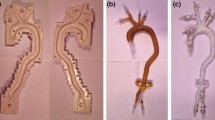Abstract
The present study was undertaken to determine whether a biventricular bypass total artificial heart driven in an independent variable rate mode can maintain circulation in vital organs such as the brain and kidney. Special emphasis was placed on investigating flow distribution. Two pusher-plate pumps were used to bypass the right and left ventricles in 11 goats and 12 sheep with fibrillating hearts. The carotid artery and renal artery flows were then measured using an ultrasonic blood flow meter and the regional renal blood flow calculated using the hydrogen gas clearance method. Thirteen animals were kept alive for 24 hours in physiological hemodynamics but 10 animals died of shock within 24 hours. In the latter group, a decrease in the fractional distribution of flow to the kidney and renal cortex were observed. At a peak aortic pressure of less than 100 mmHg, the renal flow ratio was significantly correlated with the peak aortic pressure. It was thus concluded that the biventricular bypass total artificial heart operated in an independent variable rate mode maintains physiological circulation and is therefore able to substitute for native heart function in any situation.
Similar content being viewed by others
References
Pennington DG, Kanter KR, McBride LR, Kaiser GC, Barner HB, Miller LW, Naunheim KS, Fiore AC, Willman V. Seven years' experience with the Pierce-Donachy ventricular assist device. J Thorac Cardiovasc Surg 1988; 96: 901–911.
Hill JD, Farrar DJ, Hershon JJ, Compton PG, Avery II GJ, Liwak P, Foran WS, Dunlap TE, Levin BS. Bridge to cardiac transplantation: Successful use of prosthetic biventricular support in a patient awaiting a donor heart. Trans Am Soc Artif Intern Organs 1986; 32: 233–237.
Kanter KR, Swartz MT, Pennington DG, Ruzevich SA, Madden M, McBride LR, Termuhlen DF. Renal failure in patients with ventricular assist devices. Trans Am Soc Artif Intern Organs 1987; 33: 426–428.
Parascandola SA, Pae Jr We, Davis PK, Miller CA, Pierce WS, Waldhausen JA. Determinants of survival in patients with ventricular assist device. Trans Am Soc Artif Intern Organs 1988; 34: 222–228.
Takatani S, Tanaka T, Takano H, Nakatani T, Taenaka Y, Umezu M, Matsuda T, Iwata H, Noda H, Nakamura T Seki J, Hayashi K, Akutsu T. Development of a high performance implantable total artificial heart system. Life Support Systems 1984; 2 (suppl): 249–251.
Takatani S, Harasaki H, Suwa S, Murabayashi S, Sukalac R, Jacobs G, Kiraly R, Nose Y. Pusher-plate type TAH system operated in the left and right free-running variable rate mode. Artificial Organs 1981; 5: 132–142.
Stosseck K, Lubbers DW, Cottin N. Determination of local blood flow (microflow) by electrochemically generated hydrogen: construction and application of the measuring probe. Pflugers Arch 1974; 348: 225–238.
Koshu K, Kamiyama K, Oka N, Endo S, Takaku A, Saito T. Measurement of regional blood flow using hydrogen gas generated by electrolysis. Stroke 1982; 13: 483–487.
Adachi H, Strauss HW, Ochi H, Wagner HN. The effect of hypoxia on the regional distribution of cardiac output in the dog. Cir Res 1976; 39: 314–319.
Forsyth RP, Hoffbrand BI, Melmon KL. Redistribution of cardiac output during hemorrhage in the uanesthetized monkey. Cir Res 1970; 27: 311–320.
Abe Y, Dixon F, NcNay JL. Dissociation between autoregulation of renal blood flow and glomerular filtration rate. Am J Physio 1970; 219: 986–993.
Thames MD. Contribution of cardiopulmonary baroreceptors to the control of the kidney. Federation Proc 1978; 37: 1209–1213.
Karim F, Mackay D, Kappagoda CT. Influence of carotid sinus pressure on receptors and renal blood flow. Am J Physiol 1982; 242: H220-H226.
Ammons WS, Santiesteban HL, Koyama S, Manning JW. Carotid baroreflex regulation of plasma renin levels. Am J Physiol 1980; 239: H342-H348.
Stein JH, Boonjareran S, Mauk RC, Ferris TF. Mechanism of redistribution of renal cortical blood flow during hemorrhagic hypotension in the dog. J Clin Invest 1973; 52: 39–47.
Carriere S, Thorburn GD, O'Morchoe CCC, Barger AC. Intrarenal distribution of blood flow in dogs during hemorrhagic hypotension. Circ Res 1966; 19: 167–179.
Author information
Authors and Affiliations
Rights and permissions
About this article
Cite this article
Ishino, K. A hemodynamic study of the biventricular bypass total artificial heart with special reference to intrarenal flow distribution. The Japanese Journal of Surgery 21, 312–321 (1991). https://doi.org/10.1007/BF02470953
Received:
Issue Date:
DOI: https://doi.org/10.1007/BF02470953




